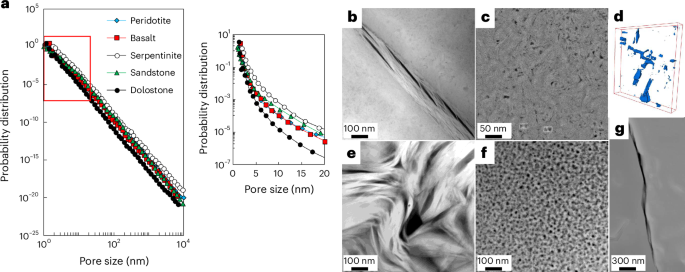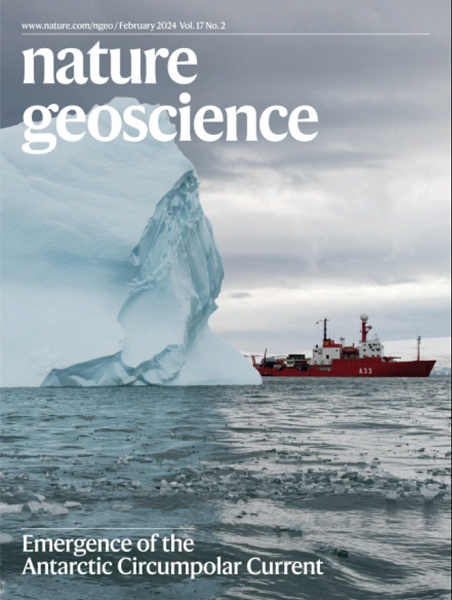纳米约束改性岩石圈含水流体的地球化学
IF 16.1
1区 地球科学
Q1 GEOSCIENCES, MULTIDISCIPLINARY
引用次数: 0
摘要
水是地球流体的主要成分,它与岩石的相互作用影响着岩石圈的地球化学和地球动力过程。水与岩石的相互作用对社会相关的资源管理至关重要,包括地下能源的开采和储存、深层碳循环以及关键金属矿床的生成。目前的主流观点认为,流体在岩石圈中穿行时不会受到纳米尺度物质所产生的独特性质的影响。在这里,我们利用电子显微镜和中子散射数据表明,各种岩石圈岩石,包括砂岩、橄榄岩和蛇纹岩,都持续显示出纳米孔隙度,主要是孔隙大小< 100纳米。利用分子动力学模拟,我们证明了水的介电常数--支配其地球化学行为的基本特性--在从环境到 700 °C 和 5 GPa 的极端条件下,其纳米孔隙率与其体积对应物存在差异。我们的地球化学模拟表明,封闭导致的水介电常数变化将降低矿物溶解度,而这一过程目前在流体-岩石相互作用模型中尚未被考虑。鉴于介电常数还与离子种类密切相关,因此在流体-岩石相互作用过程中,与孔隙大小相关的性质应该会对岩石反应性和流体的地球化学演化产生主要影响。本文章由计算机程序翻译,如有差异,请以英文原文为准。


Geochemistry of lithospheric aqueous fluids modified by nanoconfinement
Water is a principal component of Earth’s fluids, and its interaction with rocks governs lithospheric geochemical and geodynamic processes. Water–rock interactions are crucial in societally relevant resource management, including subsurface extraction and storage of energy, the deep carbon cycle and generating critical metal deposits. The prevailing view is that fluids navigate through the lithosphere without being influenced by the distinct properties that arise from matter confined at the nanoscale. Here we use electron microscopy and neutron scattering data to show that a diverse range of lithospheric rocks, including sandstones, peridotites and serpentinites, consistently show nanoporosity, predominantly with pore sizes < 100 nanometres. Using molecular dynamics simulations, we demonstrate that water’s dielectric permittivity—a fundamental property that governs its geochemical behaviour—diverges in nanoconfinement from its bulk counterpart under conditions ranging from ambient to extremes of 700 °C and 5 GPa. Our geochemical simulations suggest that changes in water permittivity due to confinement will decrease mineral solubility, a process that is not currently considered in models of fluid–rock interactions. Given that permittivity is also intimately linked to ion speciation, pore-size-dependent properties should be expected to exert a primary influence on rock reactivity and the geochemical evolution of fluids during fluid–rock interactions. Diverse lithospheric rocks show nanoporosity that changes the geochemistry of fluids and rock reactivity during fluid–rock interactions, according to a study including electron microscopy, molecular dynamics and thermodynamic modelling.
求助全文
通过发布文献求助,成功后即可免费获取论文全文。
去求助
来源期刊

Nature Geoscience
地学-地球科学综合
CiteScore
26.70
自引率
1.60%
发文量
187
审稿时长
3.3 months
期刊介绍:
Nature Geoscience is a monthly interdisciplinary journal that gathers top-tier research spanning Earth Sciences and related fields.
The journal covers all geoscience disciplines, including fieldwork, modeling, and theoretical studies.
Topics include atmospheric science, biogeochemistry, climate science, geobiology, geochemistry, geoinformatics, remote sensing, geology, geomagnetism, paleomagnetism, geomorphology, geophysics, glaciology, hydrology, limnology, mineralogy, oceanography, paleontology, paleoclimatology, paleoceanography, petrology, planetary science, seismology, space physics, tectonics, and volcanology.
Nature Geoscience upholds its commitment to publishing significant, high-quality Earth Sciences research through fair, rapid, and rigorous peer review, overseen by a team of full-time professional editors.
 求助内容:
求助内容: 应助结果提醒方式:
应助结果提醒方式:


